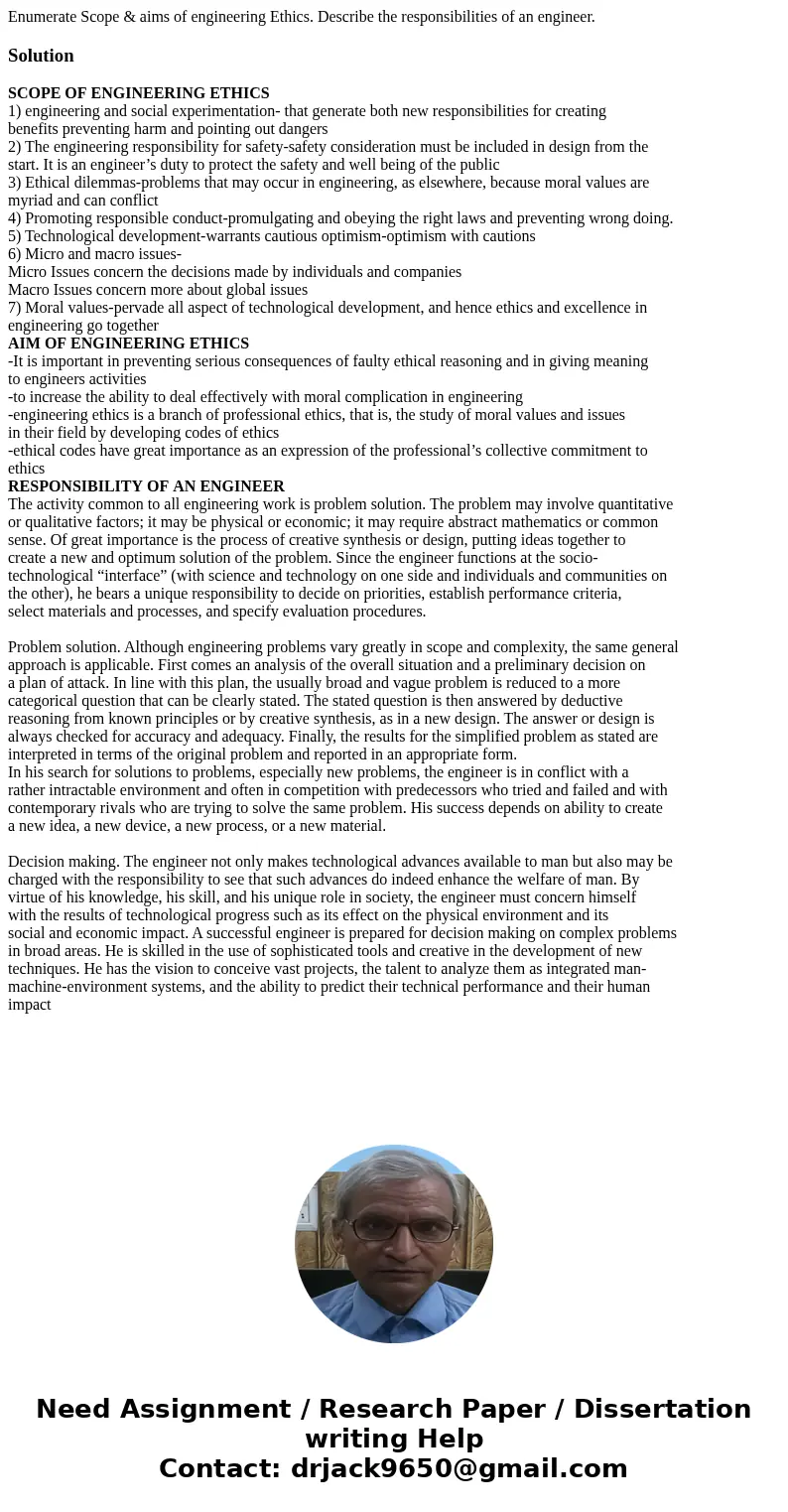Enumerate Scope aims of engineering Ethics Describe the res
Enumerate Scope & aims of engineering Ethics. Describe the responsibilities of an engineer.
Solution
SCOPE OF ENGINEERING ETHICS
1) engineering and social experimentation- that generate both new responsibilities for creating
benefits preventing harm and pointing out dangers
2) The engineering responsibility for safety-safety consideration must be included in design from the
start. It is an engineer’s duty to protect the safety and well being of the public
3) Ethical dilemmas-problems that may occur in engineering, as elsewhere, because moral values are
myriad and can conflict
4) Promoting responsible conduct-promulgating and obeying the right laws and preventing wrong doing.
5) Technological development-warrants cautious optimism-optimism with cautions
6) Micro and macro issues-
Micro Issues concern the decisions made by individuals and companies
Macro Issues concern more about global issues
7) Moral values-pervade all aspect of technological development, and hence ethics and excellence in
engineering go together
AIM OF ENGINEERING ETHICS
-It is important in preventing serious consequences of faulty ethical reasoning and in giving meaning
to engineers activities
-to increase the ability to deal effectively with moral complication in engineering
-engineering ethics is a branch of professional ethics, that is, the study of moral values and issues
in their field by developing codes of ethics
-ethical codes have great importance as an expression of the professional’s collective commitment to
ethics
RESPONSIBILITY OF AN ENGINEER
The activity common to all engineering work is problem solution. The problem may involve quantitative
or qualitative factors; it may be physical or economic; it may require abstract mathematics or common
sense. Of great importance is the process of creative synthesis or design, putting ideas together to
create a new and optimum solution of the problem. Since the engineer functions at the socio-
technological “interface” (with science and technology on one side and individuals and communities on
the other), he bears a unique responsibility to decide on priorities, establish performance criteria,
select materials and processes, and specify evaluation procedures.
Problem solution. Although engineering problems vary greatly in scope and complexity, the same general
approach is applicable. First comes an analysis of the overall situation and a preliminary decision on
a plan of attack. In line with this plan, the usually broad and vague problem is reduced to a more
categorical question that can be clearly stated. The stated question is then answered by deductive
reasoning from known principles or by creative synthesis, as in a new design. The answer or design is
always checked for accuracy and adequacy. Finally, the results for the simplified problem as stated are
interpreted in terms of the original problem and reported in an appropriate form.
In his search for solutions to problems, especially new problems, the engineer is in conflict with a
rather intractable environment and often in competition with predecessors who tried and failed and with
contemporary rivals who are trying to solve the same problem. His success depends on ability to create
a new idea, a new device, a new process, or a new material.
Decision making. The engineer not only makes technological advances available to man but also may be
charged with the responsibility to see that such advances do indeed enhance the welfare of man. By
virtue of his knowledge, his skill, and his unique role in society, the engineer must concern himself
with the results of technological progress such as its effect on the physical environment and its
social and economic impact. A successful engineer is prepared for decision making on complex problems
in broad areas. He is skilled in the use of sophisticated tools and creative in the development of new
techniques. He has the vision to conceive vast projects, the talent to analyze them as integrated man-
machine-environment systems, and the ability to predict their technical performance and their human
impact

 Homework Sourse
Homework Sourse